The Synthetic Turf Market is estimated to be valued at USD 9.2 billion in 2025 and is projected to reach USD 15.2 billion by 2035, registering a compound annual growth rate (CAGR) of 5.2% over the forecast period. In the first five-year phase (2025 to 2030), the market is expected to grow from USD 9.2 billion to USD 12.2 billion, adding USD 3 billion, which accounts for 50% of the total incremental growth, fueled by rising investments in sports infrastructure and urban landscaping projects. The second phase (2030 to 2035) contributes USD 3 billion, representing 50% of incremental growth, reflecting continued adoption in landscaping, schools, and residential applications.
Annual increments will increase from USD 0.4 billion in the early years to USD 0.6 billion by 2035, reflecting the growing shift towards low-maintenance, water-efficient outdoor solutions. Manufacturers focusing on innovative, eco-friendly, and cost-effective turf solutions will capture the largest share of this USD 6 billion opportunity, especially in regions with limited natural grass resources.
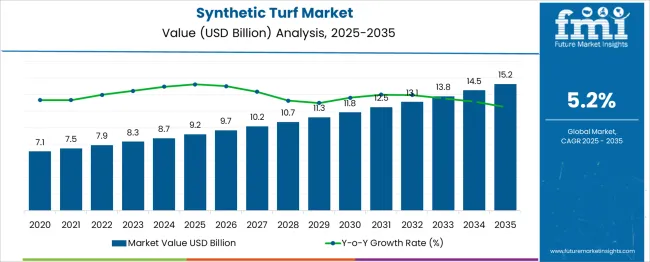
| Metric | Value |
|---|---|
| Synthetic Turf Market Estimated Value in (2025 E) | USD 9.2 billion |
| Synthetic Turf Market Forecast Value in (2035 F) | USD 15.2 billion |
| Forecast CAGR (2025 to 2035) | 5.2% |
The synthetic turf market is experiencing accelerated growth as industries and municipalities prioritize sustainable, low-maintenance surface solutions for recreational and functional use. Rising environmental concerns, coupled with water conservation mandates and increasing maintenance costs associated with natural grass, have contributed significantly to the adoption of synthetic turf. Technological improvements in turf fibers, drainage systems, and surface shock absorption have enhanced the performance and lifespan of synthetic installations.
Additionally, growing investments in sports infrastructure, landscaping for residential and commercial developments, and institutional usage are further expanding the market. Changing consumer preferences for durable and aesthetically consistent surfaces have positioned synthetic turf as a viable solution across applications.
Future growth momentum is being reinforced by government-led urban beautification programs and increasing preference for all-weather surfaces that require minimal upkeep. As awareness regarding the environmental and operational benefits of synthetic turf continues to rise, demand is expected to strengthen across both mature and emerging markets..
The synthetic turf market is segmented by material, application, distribution channel, and geographic regions. The materials used in synthetic turf are divided into Polyethylene (PE), Polypropylene (PP), and Nylon. In terms of application, the synthetic turf market is classified into Sports fields, Residential landscaping, Commercial landscaping, and others (rooftop gardens, pet turf, etc). The distribution channel of the synthetic turf market is segmented into offline and online. Regionally, the synthetic turf industry is classified into North America, Latin America, Western Europe, Eastern Europe, Balkan & Baltic Countries, Russia & Belarus, Central Asia, East Asia, South Asia & Pacific, and the Middle East & Africa.
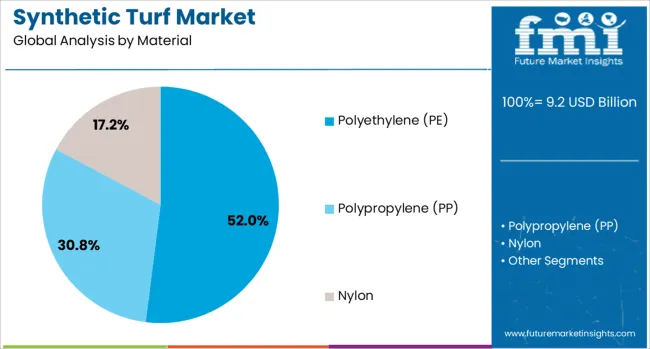
The polyethylene material segment is projected to account for 52% of the synthetic turf market revenue share in 2025, establishing it as the leading material type. This dominance has been supported by polyethylene’s superior softness, natural appearance, and high resilience, which collectively enhance player comfort and surface durability. The material has been preferred for its ability to closely replicate the look and feel of natural grass, making it suitable for both professional sports fields and landscape installations.
Polyethylene fibers offer enhanced UV resistance, tensile strength, and wear tolerance, all of which contribute to a longer lifecycle with minimal degradation under high foot traffic. Additionally, manufacturers have increasingly focused on refining polyethylene formulations to meet stringent performance standards for safety and aesthetics.
The material’s compatibility with multi-layer infill systems and its versatility across climate zones have also supported its widespread adoption. These benefits, combined with consistent product innovation, have reinforced polyethylene’s market-leading position..
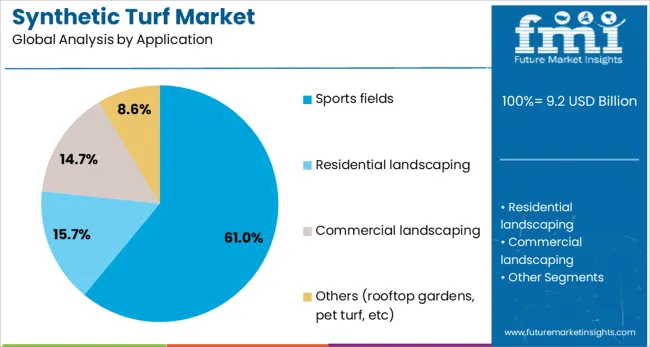
The sports fields application segment is expected to command 61% of the synthetic turf market revenue share in 2025, making it the most dominant application. This leadership has been driven by increasing investments in sports infrastructure across both developed and developing regions. The use of synthetic turf in stadiums, training facilities, and school athletic grounds has gained traction due to its durability, low maintenance, and ability to withstand intense usage without deterioration.
Unlike natural grass, synthetic surfaces offer consistent playability regardless of weather conditions, reducing downtime and scheduling disruptions. Additionally, evolving standards from sports governing bodies have endorsed the use of high-performance synthetic turf for professional play.
The surface’s injury mitigation characteristics, water conservation benefits, and reduced chemical maintenance requirements have made it a preferred choice for institutions and municipalities. The long-term cost savings associated with synthetic installations, along with the ability to support multifunctional use, continue to drive strong adoption across sports field applications..
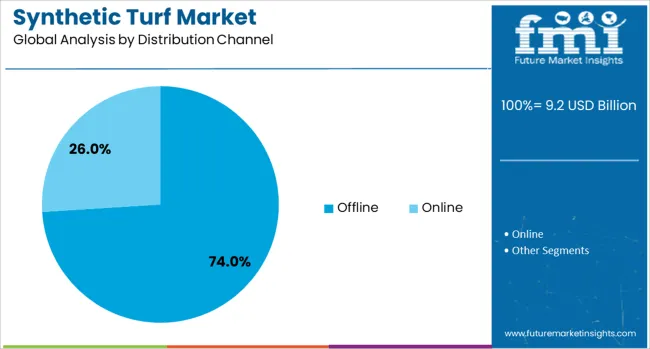
The offline distribution channel segment is projected to hold 74% of the synthetic turf market revenue share in 2025, maintaining its status as the primary distribution pathway. This segment’s prominence has been sustained by the complex and customized nature of synthetic turf installations, which often require site assessments, tailored specifications, and professional consultations. Offline channels, including direct sales, dealer networks, and commercial partnerships, provide clients with value-added services such as technical support, surface customization, and post-installation guidance.
Contractors, architects, and facility managers have consistently relied on offline suppliers for reliable sourcing and on-ground expertise, particularly for large-scale projects. Additionally, the offline model supports quality assurance and long-term service contracts, which are critical in institutional and commercial sectors.
The ability to deliver turnkey solutions through integrated offline distribution has strengthened customer confidence and contributed to repeat business. As product specifications become more sophisticated, the offline channel is expected to retain its strategic importance in driving high-value sales..
The synthetic turf market is driven by increasing demand for low-maintenance landscaping and sports surfaces. Opportunities are growing in sports and recreational applications, while trends toward eco-friendly and recyclable materials are reshaping the market. However, high initial costs and heat retention challenges could slow growth. By 2025, overcoming these obstacles through innovation and cost-effective solutions will be crucial for continued market expansion.
The synthetic turf market is growing due to the rising demand for low-maintenance landscaping solutions and sports surfaces. Synthetic turf offers several advantages, such as reduced water consumption, easy maintenance, and long-lasting durability, making it ideal for both residential and commercial applications. The increasing preference for artificial grass in sports fields, playgrounds, and lawns is expected to continue driving the market. By 2025, this trend toward convenient, low-maintenance outdoor spaces will further support the market's growth.
Opportunities in the synthetic turf market are expanding in sports and recreational applications. Synthetic turf is widely used in football, soccer, and baseball fields due to its ability to withstand heavy use and adverse weather conditions. The growing number of sports tournaments, increased recreational activities, and the rise in outdoor events are boosting demand for high-quality artificial turf. By 2025, the growing popularity of synthetic turf in sports and recreational spaces will continue to drive demand and market expansion.
Emerging trends in the synthetic turf market include the development of eco-friendly and recyclable turf materials. Manufacturers are increasingly focused on producing synthetic turf from recyclable materials, reducing environmental impact. The shift toward more sustainable synthetic turf options is driven by growing consumer awareness and stricter environmental regulations. By 2025, these eco-friendly trends will play a significant role in the market, as demand for sustainable turf options increases, particularly for large-scale projects and sports facilities.
Despite market growth, challenges such as high initial costs and heat retention remain significant in the synthetic turf market. The installation of synthetic turf requires a higher upfront investment compared to natural grass, which can be a deterrent for some consumers and municipalities. Additionally, synthetic turf tends to retain heat, making it less comfortable in hot climates. By 2025, addressing these challenges through cost reduction and improvements in heat management will be crucial to expanding the market's reach.
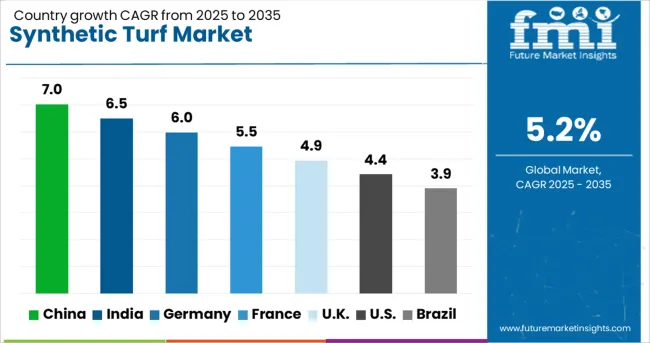
| Country | CAGR |
|---|---|
| China | 7.0% |
| India | 6.5% |
| Germany | 6.0% |
| France | 5.5% |
| UK | 4.9% |
| USA | 4.4% |
| Brazil | 3.9% |
The global synthetic turf market is projected to grow at a 5.2% CAGR from 2025 to 2035. China leads with a growth rate of 7.0%, followed by India at 6.5%, and France at 5.5%. The United Kingdom records a growth rate of 4.9%, while the United States shows the slowest growth at 4.4%. These differences in growth rates are driven by factors such as increasing demand for sustainable sports and recreational facilities, advancements in manufacturing technologies, and the rising focus on eco-friendly, low-maintenance alternatives to natural grass. Emerging markets like China and India are witnessing higher growth due to urbanization, expanding sports infrastructure, and rising consumer demand for synthetic turf in both residential and commercial applications, while more mature markets like the USA and the UK experience steady growth driven by established demand in sports facilities and landscaping. This report includes insights on 40+ countries; the top markets are shown here for reference.
The synthetic turf market in China is growing rapidly, with a projected CAGR of 7.0%. China’s booming construction and sports sectors are major drivers of demand for synthetic turf, particularly in sports fields, recreational parks, and landscaping applications. The country’s growing emphasis on building sustainable and energy-efficient infrastructures is contributing to the rising adoption of synthetic turf, which offers low maintenance and high durability. Additionally, China’s urbanization and rising investments in sports facilities and recreational infrastructure further boost the demand for synthetic turf in both public and private projects.
The synthetic turf market in India is projected to grow at a CAGR of 6.5%. India’s growing urbanization, combined with rising investments in sports infrastructure, is driving the demand for synthetic turf. The increasing popularity of sports like football, cricket, and hockey, coupled with the need for cost-effective, low-maintenance solutions in stadiums and recreational facilities, supports market growth. Additionally, the increasing demand for synthetic turf in landscaping applications, as well as government initiatives to develop public spaces, contributes to the growing adoption of synthetic turf in both commercial and residential projects.
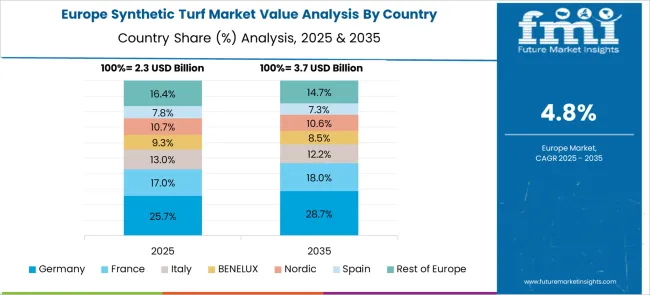
The synthetic turf market in France is projected to grow at a CAGR of 5.5%. France’s well-established sports infrastructure, combined with a rising demand for low-maintenance and eco-friendly landscaping solutions, continues to drive the adoption of synthetic turf. The demand for synthetic turf is particularly strong in football fields, tennis courts, and recreational parks, as well as in residential and commercial landscaping. Additionally, the country’s growing emphasis on sustainable building practices, coupled with advancements in manufacturing technologies that improve the quality of synthetic turf, supports continued market growth.
The synthetic turf market in the United Kingdom is projected to grow at a CAGR of 4.9%. The UK continues to see steady demand for synthetic turf, driven by the need for high-performance, low-maintenance solutions in sports fields, landscaping, and public spaces. The increasing focus on sustainability and eco-friendly materials, coupled with rising investments in sports infrastructure, is contributing to the growth of the market. The UK’s emphasis on reducing water consumption and the growing demand for versatile and durable synthetic turf in recreational and residential areas further boosts market adoption.
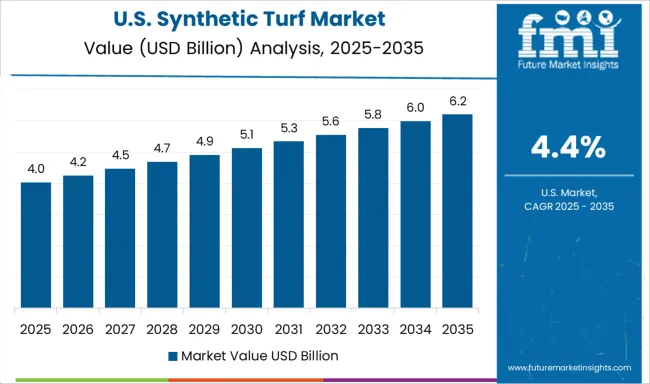
The synthetic turf market in the United States is expected to grow at a CAGR of 4.4%. The USA market remains steady, driven by continued demand from the sports sector, particularly football, soccer, and baseball fields, as well as recreational areas. The rise in popularity of synthetic turf in residential landscaping and the increasing demand for eco-friendly and water-efficient solutions contribute to market growth. However, the growth rate in the USA is slower compared to emerging markets, due to market maturity, established infrastructure, and the widespread adoption of synthetic turf in existing sports facilities and landscapes.
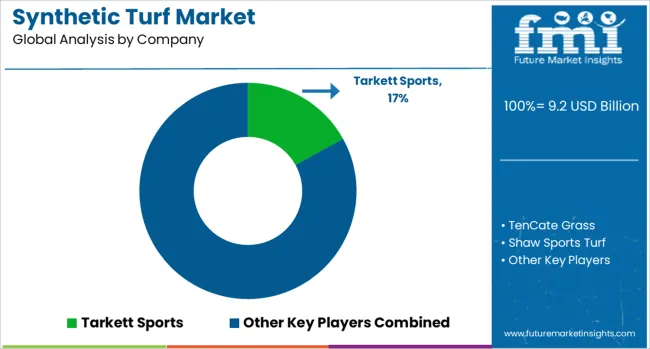
The synthetic turf market is dominated by Tarkett Sports, which leads with its high-performance turf systems used in sports fields, playgrounds, and landscaping applications. Tarkett’s dominance is reinforced by its strong focus on innovation, sustainability, and providing durable, high-quality synthetic turf solutions that mimic natural grass. Key players such as TenCate Grass, Shaw Sports Turf, and FieldTurf (a Tarkett brand) maintain significant market shares by offering a wide range of turf products designed for various applications, including professional sports, recreational facilities, and residential landscaping.
These companies focus on enhancing product durability, improving shock absorption, and ensuring easy maintenance for long-lasting performance. Emerging players like SportGroup and CCGrass are expanding their market presence by offering customized synthetic turf solutions for niche applications, including eco-friendly options and turf systems designed for extreme weather conditions.
Their strategies include improving the sustainability of turf materials, increasing product customization, and addressing regional demands for affordable yet high-quality synthetic grass solutions. Market growth is driven by increasing demand for low-maintenance, eco-friendly turf solutions in sports facilities and landscaping, as well as the growing adoption of synthetic turf in recreational areas. Innovations in turf material technologies, including enhanced fiber resilience and water-saving systems, are expected to continue shaping competitive dynamics and fuel further growth in the global synthetic turf market.
| Item | Value |
|---|---|
| Quantitative Units | USD 9.2 Billion |
| Material | Polyethylene (PE), Polypropylene (PP), and Nylon |
| Application | Sports fields, Residential landscaping, Commercial landscaping, and Others (rooftop gardens, pet turf, etc) |
| Distribution Channel | Offline and Online |
| Regions Covered | North America, Europe, Asia-Pacific, Latin America, Middle East & Africa |
| Country Covered | United States, Canada, Germany, France, United Kingdom, China, Japan, India, Brazil, South Africa |
| Key Companies Profiled | Tarkett Sports, TenCate Grass, Shaw Sports Turf, FieldTurf (a Tarkett brand), SportGroup, and CCGrass |
| Additional Attributes | Dollar sales by turf type and application, demand dynamics across sports, landscaping, and residential sectors, regional trends in synthetic turf adoption, innovation in eco-friendly and durable materials, impact of regulatory standards on safety and performance, and emerging use cases in urban green spaces and recreational facilities. |
The global synthetic turf market is estimated to be valued at USD 9.2 billion in 2025.
The market size for the synthetic turf market is projected to reach USD 15.2 billion by 2035.
The synthetic turf market is expected to grow at a 5.2% CAGR between 2025 and 2035.
The key product types in synthetic turf market are polyethylene (pe), polypropylene (pp) and nylon.
In terms of application, sports fields segment to command 61.0% share in the synthetic turf market in 2025.






Our Research Products

The "Full Research Suite" delivers actionable market intel, deep dives on markets or technologies, so clients act faster, cut risk, and unlock growth.

The Leaderboard benchmarks and ranks top vendors, classifying them as Established Leaders, Leading Challengers, or Disruptors & Challengers.

Locates where complements amplify value and substitutes erode it, forecasting net impact by horizon

We deliver granular, decision-grade intel: market sizing, 5-year forecasts, pricing, adoption, usage, revenue, and operational KPIs—plus competitor tracking, regulation, and value chains—across 60 countries broadly.

Spot the shifts before they hit your P&L. We track inflection points, adoption curves, pricing moves, and ecosystem plays to show where demand is heading, why it is changing, and what to do next across high-growth markets and disruptive tech

Real-time reads of user behavior. We track shifting priorities, perceptions of today’s and next-gen services, and provider experience, then pace how fast tech moves from trial to adoption, blending buyer, consumer, and channel inputs with social signals (#WhySwitch, #UX).

Partner with our analyst team to build a custom report designed around your business priorities. From analysing market trends to assessing competitors or crafting bespoke datasets, we tailor insights to your needs.
Supplier Intelligence
Discovery & Profiling
Capacity & Footprint
Performance & Risk
Compliance & Governance
Commercial Readiness
Who Supplies Whom
Scorecards & Shortlists
Playbooks & Docs
Category Intelligence
Definition & Scope
Demand & Use Cases
Cost Drivers
Market Structure
Supply Chain Map
Trade & Policy
Operating Norms
Deliverables
Buyer Intelligence
Account Basics
Spend & Scope
Procurement Model
Vendor Requirements
Terms & Policies
Entry Strategy
Pain Points & Triggers
Outputs
Pricing Analysis
Benchmarks
Trends
Should-Cost
Indexation
Landed Cost
Commercial Terms
Deliverables
Brand Analysis
Positioning & Value Prop
Share & Presence
Customer Evidence
Go-to-Market
Digital & Reputation
Compliance & Trust
KPIs & Gaps
Outputs
Full Research Suite comprises of:
Market outlook & trends analysis
Interviews & case studies
Strategic recommendations
Vendor profiles & capabilities analysis
5-year forecasts
8 regions and 60+ country-level data splits
Market segment data splits
12 months of continuous data updates
DELIVERED AS:
PDF EXCEL ONLINE
Synthetic Dye Market Forecast Outlook 2025 to 2035
Synthetic Data Generation Market Size and Share Forecast Outlook 2025 to 2035
Synthetic Biology Market Size and Share Forecast Outlook 2025 to 2035
Synthetic Abrasives Market Size and Share Forecast Outlook 2025 to 2035
Synthetic Zeolite Y Adsorbent Market Size and Share Forecast Outlook 2025 to 2035
Synthetic Musk Market Size and Share Forecast Outlook 2025 to 2035
Synthetic Tackifiers Market Size and Share Forecast Outlook 2025 to 2035
Synthetic Spider Silk Proteins Market Analysis - Size, Share, and Forecast Outlook 2025 to 2035
Synthetic Polymer Wax Market Size and Share Forecast Outlook 2025 to 2035
Synthetic Aperture Radar (SAR) Market Size and Share Forecast Outlook 2025 to 2035
Synthetic Diamond Market Size and Share Forecast Outlook 2025 to 2035
Synthetic Food Market Size and Share Forecast Outlook 2025 to 2035
Synthetic Polyisoprene Rubber Market Report – Trends & Innovations 2025–2035
Synthetic and Bio Emulsion Polymer Market Size and Share Forecast Outlook 2025 to 2035
Synthetic And Bio Based PMMA Polymethyl Methacrylate Size Market Size and Share Forecast Outlook 2025 to 2035
Synthetic Quartz Market Size and Share Forecast Outlook 2025 to 2035
Synthetic Leather Market Forecast & Growth 2025 to 2035
Synthetic Quartz Industry Analysis in Japan - Size, Share, & Forecast Outlook 2025 to 2035
Synthetic Food Color Market Analysis - Size, Share, and Forecast Outlook 2025 to 2035
Synthetic Paper Market Insights - Growth & Trends Forecast 2025 to 2035

Thank you!
You will receive an email from our Business Development Manager. Please be sure to check your SPAM/JUNK folder too.
Chat With
MaRIA